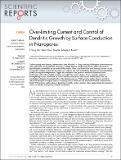Over-limiting Current and Control of Dendritic Growth by Surface Conduction in Nanopores
Author(s)
Han, Ji-Hyung; Bai, Peng; Bazant, Martin Z.; Khoo, Edwin Sze Lun
DownloadHan-2014-Over-limiting current.pdf (1.980Mb)
PUBLISHER_CC
Publisher with Creative Commons License
Creative Commons Attribution
Terms of use
Metadata
Show full item recordAbstract
Understanding over-limiting current (faster than diffusion) is a long-standing challenge in electrochemistry with applications in desalination and energy storage. Known mechanisms involve either chemical or hydrodynamic instabilities in unconfined electrolytes. Here, it is shown that over-limiting current can be sustained by surface conduction in nanopores, without any such instabilities, and used to control dendritic growth during electrodeposition. Copper electrodeposits are grown in anodized aluminum oxide membranes with polyelectrolyte coatings to modify the surface charge. At low currents, uniform electroplating occurs, unaffected by surface modification due to thin electric double layers, but the morphology changes dramatically above the limiting current. With negative surface charge, growth is enhanced along the nanopore surfaces, forming surface dendrites and nanotubes behind a deionization shock. With positive surface charge, dendrites avoid the surfaces and are either guided along the nanopore centers or blocked from penetrating the membrane.
Date issued
2014-11Department
Massachusetts Institute of Technology. Department of Chemical Engineering; Massachusetts Institute of Technology. Department of MathematicsJournal
Scientific Reports
Publisher
Nature Publishing Group
Citation
Han, Ji-Hyung, Edwin Khoo, Peng Bai, and Martin Z. Bazant. “Over-Limiting Current and Control of Dendritic Growth by Surface Conduction in Nanopores.” Sci. Rep. 4 (November 14, 2014): 7056.
Version: Final published version
ISSN
2045-2322